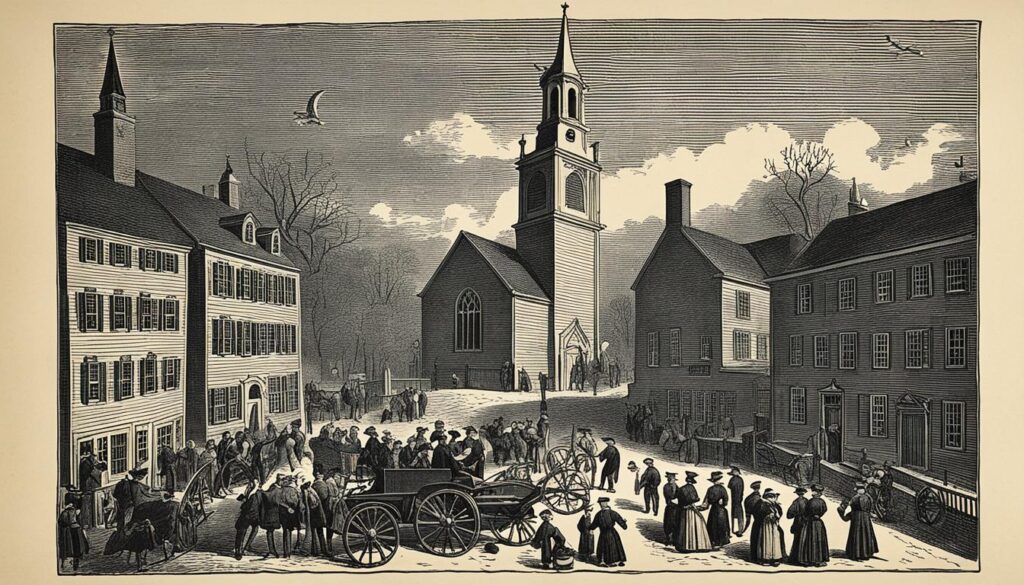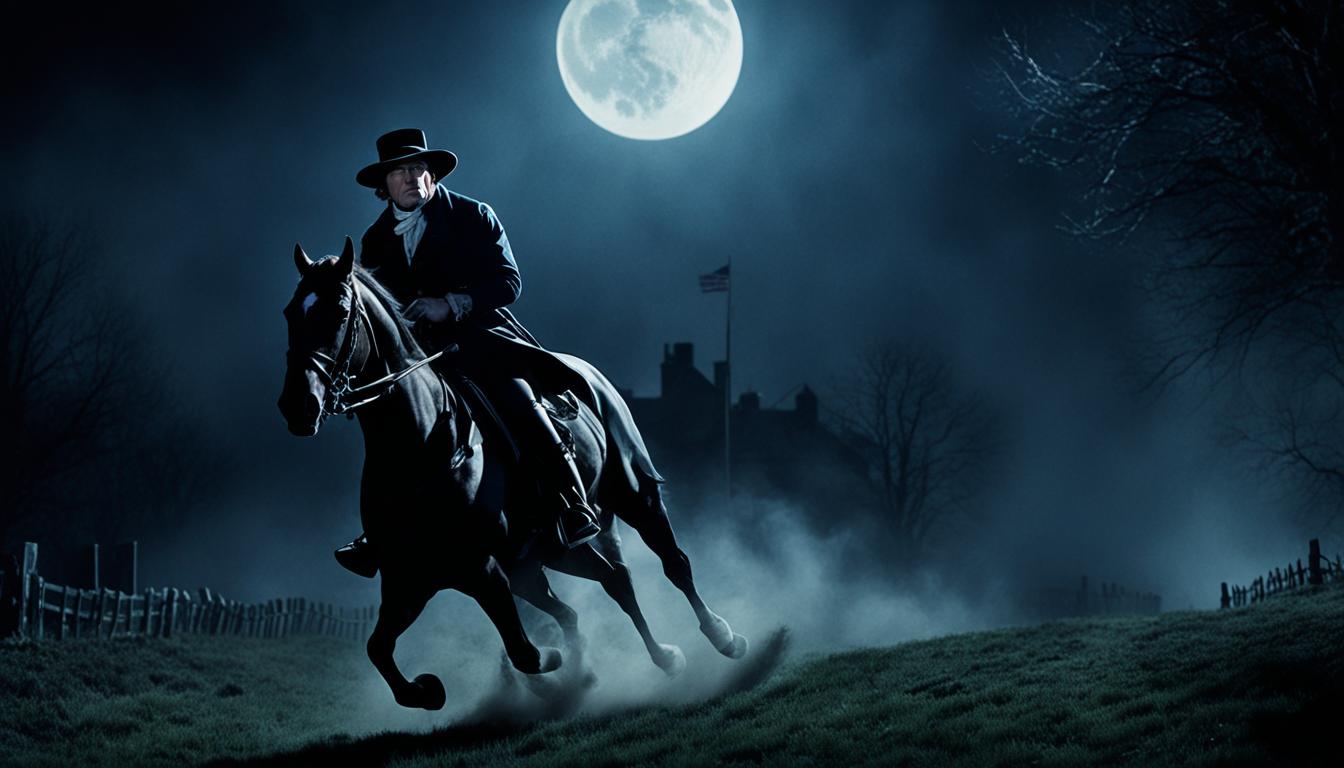Paul Revere’s legendary midnight ride on April 18, 1775, wasn’t as loud as we think. He didn’t shout, “The British are coming!” Instead, Revere’s mission was quiet and well-planned.
His goal? To warn Samuel Adams and John Hancock about British soldiers heading to Lexington and Concord. Revere, a Boston silversmith, was key to the American Revolution’s early stages.
Revere’s ride was a team effort. It involved lantern signals in the Old North Church. These lights alerted patriots across the Charles River about British movements.
During his journey, Revere quietly told local militia leaders that the “Regulars” were moving. This set up the famous battles of Lexington and Concord.
Key Takeaways
- Paul Revere’s famous ride was a crucial event in the early stages of the American Revolution.
- Contrary to popular belief, Revere did not shout warnings about the British during his midnight ride.
- Revere’s mission was to discreetly warn key figures like Samuel Adams and John Hancock about the impending arrival of British soldiers.
- A complex system of lantern signals in the Old North Church was used to alert patriots about British movements.
- Revere’s ride set the stage for the iconic battles of Lexington and Concord, which marked the beginning of the American Revolutionary War.
Revere’s Role as a Patriot and Silversmith
Paul Revere, born in 1734, was a skilled Boston silversmith and engraver. He created beautiful silver pieces and gained fame for his artistry. Revere’s impact went beyond craftsmanship; he became a key figure in the American Revolution.
Revere joined the Sons of Liberty, opposing British taxation and organizing protests. He took part in the famous Boston Tea Party. His involvement showed his strong commitment to the patriot cause.
Revere used his engraving skills to create powerful anti-British images. His famous depiction of the Boston Massacre stirred emotions among colonists. These engravings highlighted the growing tensions between the colonies and Britain.
As a well-connected tradesman, Revere’s influence spread widely. He served as a courier for the Committee of Safety. This role allowed him to carry important messages between colonies.
Revere’s work as a silversmith, patriot, and courier made him a key revolutionary figure. His dedication to independence solidified his place in American history. Paul Revere truly embodied the spirit of the American Revolution.
The Preparation and Planning of the Midnight Ride
Paul Revere was key to an intelligence network called the “mechanics” or Liberty Boys. This group watched British soldiers and shared vital information. Revere’s work with the Sons of Liberty and Committee of Safety was crucial for his famous ride.
On April 18, 1775, Dr. Joseph Warren learned of the British plan to march to Concord. He sent Paul Revere and William Dawes to warn Samuel Adams and John Hancock. Revere created a smart signal system using lanterns in the Old North Church steeple.
The signal, “one if by land, two if by sea,” showed the British troops’ route. This clever method alerted the countryside about the approaching danger.

Revere’s network was vital in gathering info about British army plans. The Sons of Liberty and Committee of Safety stayed ahead of the British. This knowledge helped Revere and his fellow riders warn colonists effectively.
Revere’s careful planning and support from patriots were key to his ride’s success. Without the Sons of Liberty and Committee of Safety, Revere’s journey might not have been as impactful.
The prep work for the midnight ride shows the bravery of Paul Revere. It also highlights the determination of the patriots who fought with him.
The Reality of Paul Revere’s Ride
Paul Revere’s famous ride wasn’t a solo mission. He rode with William Dawes and Dr. Samuel Prescott on April 18, 1775. Their goal was to warn patriots about approaching British troops.
The trio alerted local militia leaders about the impending threat. They aimed to prepare patriots in Lexington and Concord for British forces. Communication relied on brave individuals, unlike the Washington-Moscow hotline during the Cold War.
Near Concord, the group met a British patrol in Lexington. Revere was captured, but Prescott escaped to warn Concord. This shows the ride’s success depended on multiple people working together.
The warnings allowed colonial militia to prepare for battles. Lexington and Concord marked the start of the war for independence. These events sparked the creation of a new nation.
Paul Revere’s ride, with Dawes and Prescott, symbolizes patriotism and liberty. Their efforts played a crucial role in the American Revolution.
The Legacy and Mythologizing of Revere’s Ride
Paul Revere’s midnight ride is a cornerstone of American folklore. Henry Wadsworth Longfellow’s 1860 poem greatly contributed to this legacy. The poem, while influential, added mythical elements to the events of April 18, 1775.
Longfellow’s artistic choices, like Revere shouting warnings, have become part of popular culture. These embellishments often overshadow the historical facts of the American Revolution. However, they don’t diminish the importance of Revere’s actions.
Revere’s bravery during the Revolution’s early stages remains undeniable. He warned the colonial militia about the British invasion. Other riders, like William Dawes and Samuel Prescott, also played crucial roles.
Revere’s ride continues to inspire generations today. It symbolizes the fight for independence and the birth of a new nation. His story exemplifies the courage and determination of American patriots.
Paul Revere is now a symbol of patriotism and revolutionary spirit. His tale, though embellished, is a treasured part of America’s cultural heritage. It reminds us of the founding fathers’ sacrifices in their pursuit of liberty.
Revere’s enduring legacy shows the power of storytelling in shaping collective memory. It highlights the importance of preserving historical truths while honoring national heroes. His ride remains a powerful symbol of America’s fight for freedom.

Leave a Reply